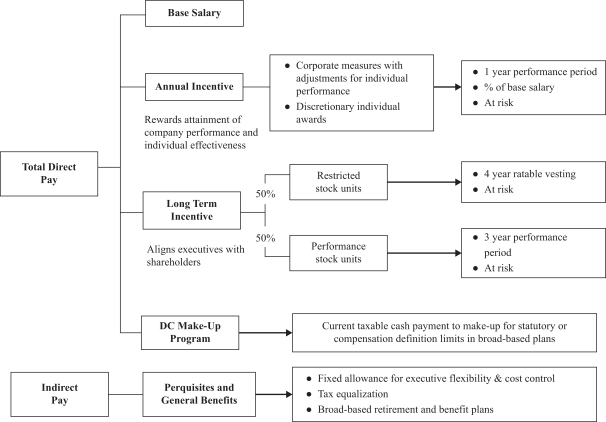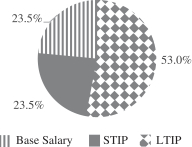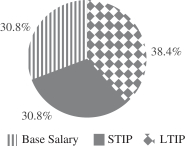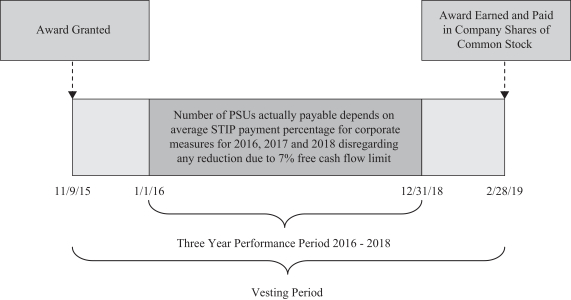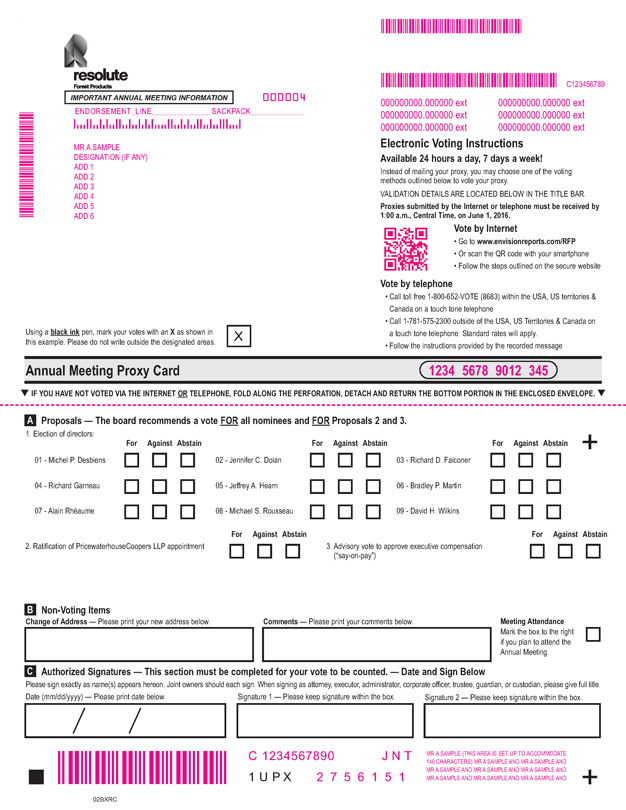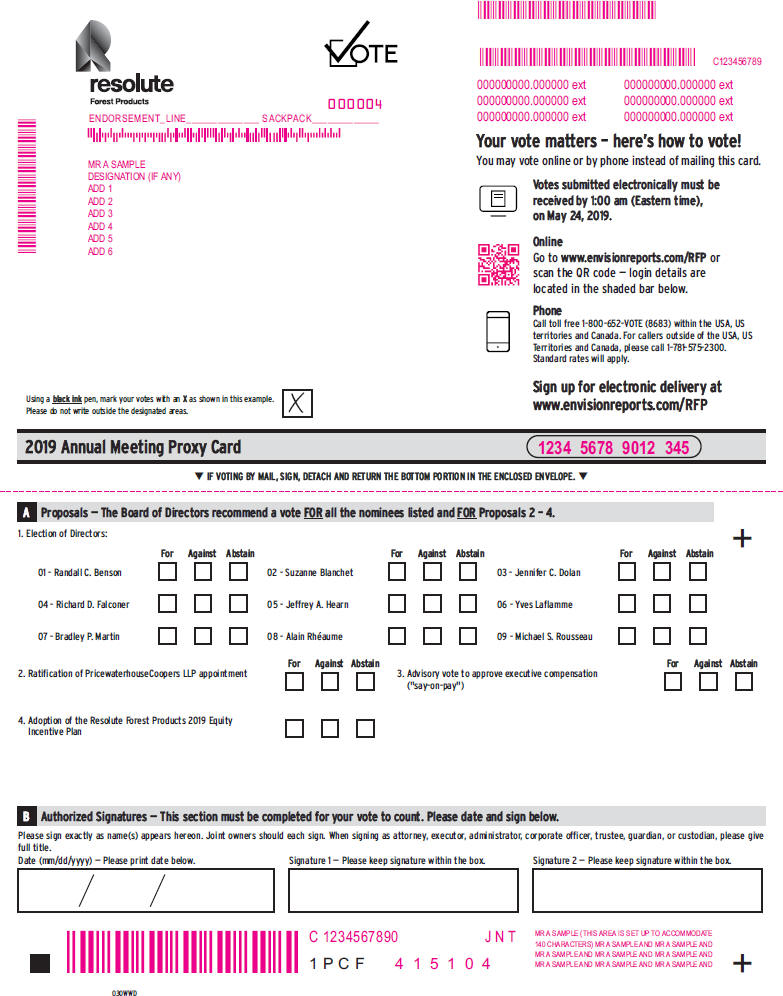Executive Compensation Process
Role of the Compensation Committee
The compensation committee independently assesses the performance goals and objectives of the president and chief executive officer and makes recommendations to the board as to the amounts and individual elements of his total compensation. The independent directors of the board ultimately approve the final compensation package for the president and chief executive officer. For the senior vice presidents, the compensation committee evaluates and approves all elements of total compensation.
Consistent with its authority under its charter, the compensation committee selects and retains its own independent advisors to provide guidance on the competitiveness and appropriateness of the compensation programs for the president and chief executive officer and all senior vice presidents. For 2015, the compensation committee retained Hugessen Consulting to provide this advice. In 2015, Hugessen Consulting’s aggregate fees were $16,202 (converted from Canadian dollars to U.S. dollars based on the average exchange rate for 2015, or $0.7816).
As more fully described below, Hugessen Consulting assists the compensation committee in benchmarking certain elements of the executive compensation program against the Company’s comparator groups (described below) and advises on the risk elements of the program. Hugessen also provides management advice on these matters, as directed by the chair of the compensation committee. While internal and external information and advice have been used in the ongoing assessment of the executive compensation programs, the compensation committee and the independent members of the board retained the full responsibility for all decisions related to the Company’s compensation programs and plans as well as their implementation.
To this end, the compensation committee evaluates total direct compensation (comprising of base salary and short-term and long-term incentives) against the median level of the Company’s comparator groups. It makes its compensation decisions on various elements at different times in the year:
| | |
February 2015 | | • Assessed Mr. Garneau’s performance for 2014
• Recommended for approval, and the independent members of the board of directors approved, the 2014 STIP payout, discretionary awards for all members of the executive team, and the terms of the 2015 STIP
• Reviewed the main elements of the executive compensation program, including perquisites, to assess any changes to the program
|
| |
May 2015 | | • Reviewed and approved recommendations to the board of directors of executive team changes in response to the Company’s strategic decision to enter the tissue business
• Approved recommendations to the board of directors of related base salary adjustments for the reconstituted executive team
|
| |
June 2015 | | • Recommended for approval, and the independent members of the board of directors approved, changes to the executive team and certain base salary adjustments for the president and chief executive officer and all senior vice presidents
|
| |
October 2015 | | • Recommended for approval, and the independent members of the board approved, the annual equity grant for management
• Assessed all senior vice presidents’ performance
• Approved a relocation package for Mr. Tremblay following the Company’s request for Mr. Tremblay to relocate closer to the Company’s Montreal headquarters
|
| |
December 2015 | | • Assessed Mr. Garneau’s performance for 2015
• Reviewed and discussed succession planning for Mr. Garneau and all senior vice presidents
• Conducted the compensation risk assessment
|
| |
February 2016 | | • Recommended for approval, and the independent members of the board of directors approved, the 2015 STIP payout and the terms of the 2016 STIP
• At management’s recommendation, discussed and decided not to approve discretionary awards to the executive team
|
2015 Say-on-Pay Vote
Stockholders approved our executive compensation with over 99% of the votes cast in favor of the non-binding resolution approving executive compensation, or the “say-on-pay” vote, at the 2015 annual meeting of stockholders.
Setting Compensation Levels—Benchmarking Data
Our executive compensation structure adheres to a pay-for-performance framework with a mix of cash and non-cash elements. There is no formal policy for allocating a certain percentage of pay between cash and non-cash or short-term or long-term pay. The compensation committee favorsexercises discretion as needed for a mix that is more weighted to variable pay through a short-term cash incentive and a long-term, equity incentive, which puts a significant portion of compensation at-risk. The following shows the intended mix for the three main elements of pay since 2011. The weighted mix, as shown below, is based on the following assumptions: (i) base salary is the salary in effect at December 31, 2015; (ii) the 2015 STIP at target payout of 100% of base salary; (iii) the value of the annual equity grants (described below) is based on 125% of base salary (225% for the president and chief executive officer); and (iv) parity between the Canadian and U.S. dollars.
given executive’s compensation. | | | | | | | | | | | | |
| | | Total Direct Compensation | |
Level | | Base Salary | | | Short-Term
Incentive
(at Target Payout) | | | Long-
Term
Incentive | |
President and chief executive officer | | | 23.5 | % | | | 23.5 | % | | | 53.0 | % |
All other named executive officers | | | 31.0 | % | | | 31.0 | % | | | 38.0 | % |
The compensation committee annually assesses the competitiveness of aggregate total direct compensation (base salary, target short-term incentive and long-term incentives) and each element individually for the president and chief executive officer and all senior vice presidents. To make this assessment, the compensation committee uses market data based on two comparator groups. In 2014, the compensation committee worked with Hugessen to review the comparator groups and provide market data for benchmarking aggregate total direct compensation and each individual element. The compensation committee historically updated the market data every year, but beginning in 2015, the compensation committee will update the information every two years. As a result, for 2015, in consultation with Hugessen, the compensation committee used the 2014 market data, adjusted by 3%. The compensation committee will reassess the comparator groups and update the market data in 2016.
For reference in 2014, the primary comparator group consisted of 10 industry peers (“industry comparator group”). The second comparator group consisted of a blend of 14 Canadian companies and 38 U.S. companies that were part of Willis Towers Watson’s databank and selected based on industry (the forest and paper products industry) and revenues in certain commodity and other industrial industries (“blended comparator group”). Three companies appeared in both the Canadian and U.S. company comparator groups. The 38 U.S. companies in the blended comparator group also included four of the industry comparator group companies.
The industry comparator group for 2014 was comprised of the following eight U.S. companies and two Canadian companies in the pulp and paper, wood products and packaging sectors:
| | | | |
Bemis Company Inc. | | Louisiana-Pacific Corporation | | Rock-Tenn Company |
Cascades Inc. | | MeadWestvaco Corp. | | Sonoco Products Company |
Domtar Corporation | | Packaging Corporation of America | | Weyerhaeuser Company |
Graphic Packaging Holding Company | | | | |
While total direct compensation for each named executive officer was compared against both comparator groups each time a comparable position existed in both groups, the compensation committee assessed compensation adjustments against the industry comparator group for the following positions: president and chief executive officer; senior vice president, pulp and paper group; and senior vice president, wood products, procurement and information technology. The industry comparator group was appropriate for these positions because the positions require specific knowledge of the forest products industry to implement the Company’s strategic plans. When benchmarking to the industry comparator group, the position for the president and chief executive officer was matched with the chief executive officer at the comparator companies. The senior vice president, pulp and paper group and senior vice president, wood products, procurement and information technology were matched with the next two highest paid named executive officers (after the chief executive officer and chief financial officer) among the comparator companies as well as on position.
The blended comparator group was used for the senior vice president and chief financial officer because this position performs corporate functions and has a skill set that is transferable across industries. As a result, the blended comparator group was appropriate for this position. When benchmarking to the blended comparator group, the comparison was made based on position.
In addition, the blended comparator group was used for the senior vice president, tissue group, because a comparable position was not available in the industry comparator group.
The following chart shows the resulting comparisons against the respective comparator group, using salary levels in effect before the June 2015 base salary adjustments described further below under Base Salary.
| | | | | | | | | | | | |
Level
| | Comparator
Group | | Base
Salary | | Short-Term
Incentive
(at Target
Payout) | | Target
Total Cash | | Equity
Award
Value | | Total Direct
Compensation |
President and chief executive officer
| | Industry | | Below
Median | | Below
Median | | Below
Median | | Below
Median | | Below
Median |
Senior vice president and chief financial officer
| | Blended | | Below
Median | | Above
Median | | Above
Median | | Below
Median | | Below
Median |
Senior vice president, wood products, procurement and information technology
| | Industry | | Below
Median | | Above
Median | | Below
Median | | Below
Median | | Below
Median |
Senior vice president, pulp and paper operations
| | Industry | | Below
Median | | Above
Median | | Below
Median | | Below
Median | | Below
Median |
Senior vice president, pulp and paper operations
| | Industry | | Below
Median | | Above
Median | | Below
Median | | Below
Median | | Below
Median |
Elements of Our Executive Compensation Program
The following highlights the elements of the Company’s executive compensation program and the basis for the elements:
Base salary
We provide senior management with a level of assured cash compensation in the form of base salary. The compensation committee considers future adjustments in base salary as a result of changes in accountabilities and performance or if other circumstances warrant a change in base salary. When considering base salary adjustments, the compensation committee takes into account each named executive officer’s demonstrated effectiveness appraisal rating for performing the expected duties of their defined roles. Among other things, the appraisal reviews and assesses each named executive officer’s mastery of his or her roles and identifies areas for improvement.
When assessing the adjustments, the compensation committee also considers the base salary ranges for our comparator groups to assess each officer’s proximity to the median for the comparator groups. As noted above, when determining the 2015 base salary adjustments, the compensation committee reviewed the 2014 market data, adjusted by 3%. The benchmarking data showed that the base salary levels continued to be below the median level, based on the respective comparator group, for all named executive officers.
Following the compensation committee’s review of the benchmarking data and its performance assessment for all named executive officers, the compensation committee recommended, and the independent members of the board approved, effective June 1, 2015, base salary adjustments for the executive team as follows: a 10% base salary increase for Mr. Garneau, 4% base salary increase for Ms. Longworth, and 5% base salary increase for Mr. Laflamme. Messrs. Piché and Tremblay received base salary increases of 9.2% and 17.6%, respectively, primarily for recognition of their increased responsibilities. Specifically, Mr. Piché’s base salary increase recognized his new role in leading the tissue group, the Company’s new strategic business, and his continued oversight of three pulp and paper mills, while Mr. Tremblay’s base salary increase recognized that his responsibilities were significantly expanded to include oversight of the pulp and paper business unit (namely, with the exception of the pulp and paper mills under Mr. Piché’s direction, the remaining pulp and paper mills as well as pulp and paper sales and marketing). In addition, Mr. Tremblay’s responsibilities include a range of operational support functions such as operational excellence, engineering, energy, production planning, logistics, and customer service for the pulp and paper operations.
Because the executive team resides in Canada and the U.S., in 2014, the independent members of the board of directors approved a new currency policy to address currency fluctuations that can impact parity among its executive team. It also allows for smoother benchmarking to comparator companies that are paid in U.S. dollars. Specifically, base salary is established assuming parity in the Canadian and U.S. dollars, with a portion paid in Canadian dollars and a portion paid in U.S. dollars based on the geographic location of the Company’s pulp and paper production capacity as of the prior December 31. As a result, for 2015, 52% of an executive’s salary was paid in U.S. dollars and 48% in Canadian dollars. The numbers shown in the Summary Compensation Table have been converted to U.S. dollars at exchange rates disclosed in the footnotes to the table. For 2016, the portion of base salary paid in U.S. dollars versus Canadian dollars changed slightly to 53% and 47%, respectively, based on the geographic mix of the Company’s pulp and paper production capacity as of December 31, 2015.
2015 STIP
The annual short-term incentive plan awards all named executive officers for the achievement of the following performance measures that reflect the Company’s business strategy and factors driving shareholder value:
Generating targeted income from operations;
| • | | Controlling sales and general administration costs, or “SG&A costs”;
|
Improving safety performance; and
Improving environmental performance.
As in past years, the 2015 STIP did not reward individual performance and instead remained focused on rewarding corporate performance. The 2015 STIP mirrored the 2014 STIP in design. A key feature of the 2015 STIP balanced stockholder return with rewarding individuals for achieving our business objectives. Specifically, the 2015 STIP contained an overall limit on the total amount that could be paid to all eligible employees as a short-term cash incentive under the plan even if performance was met. This limit remained set at 7% of free cash flow, which is defined as net cash provided by operating activities, less maintenance, safety and environmental capital expenditures, adjusted for cash reorganization and restructuring costs, additional pension contributions toward past service and other special items.
For the president and chief executive officer and all senior vice presidents, including all named executive officers, payout levels were established as a percentage of base salary (as in effect on December 31, 2015). No officer or individual was guaranteed a minimum payout under the 2015 STIP. The 2015 STIP also provided authority to the compensation committee to adjust or cancel awards under the 2015 STIP at its discretion.
| | | | |
|
2015 STIP Payout Levels |
Threshold
| | Target | | Maximum |
50% of base salary at 12/31/15 | | 100% of base salary at 12/31/15 | | 150% of base salary at 12/31/15 |
In establishing the payout percentages, the compensation committee used benchmarking data from its comparator groups. The payout percentages have remained the same since the 2011 STIP. In general, the target threshold of 100% is above the median for our comparator groups, but, combined with the lower base salary levels in its comparator groups, reflects the compensation committee’s adherence to conditioning a significant portion of pay on Company performance.
The table below sets forth the performance measures approved by the compensation committee for the 2015 STIP that apply to the named executive officers, the associated weight given to each measure and the business objective to which it relates.
| | | | | | |
Performance Measure
| | Weight | | | Business Objective/Core Value
|
Income from operations
| | | 50 | % | | Maximizing profitability |
SG&A cost control
| | | 25 | % | | Maximizing profitability |
Safety – Frequency Rate (15%) and Severity Rate (5%) of Incidents
| | | 20 | % | | Continuous improvement of safety performance |
Environmental incidents
| | | 5 | % | | Continuous improvement of environmental performance |
All named executive officers earned a 2015 STIP award at 58.25% of their annual base salary based on weighted performance measures. As a result of the overall limit of 7% of free cash flow, the 2015 STIP payouts were reduced to 47.82% of each named executive officer’s annual base salary.
| | | | | | | | | | | | | | | | | | | | | | | | |
Performance Measure | | Target Performance | | Actual
Performance | | Actual Payout
Percentage by
Performance
Measure | | | Adjusted Payout
Percentage by
Performance
Measure | | | Weight | | | Weighted Payout
Percentage
Before Overall
Cap of Free
Cash Flow (1) | | | Weighted Payout
Percentage After
Overall Cap
of Free
Cash Flow (1) | |
Income from operations | | $197 million | | 78 million | | | 0% | | | | — | | | | 50% | | | | 0% | | | | 0% | |
SG&A cost control | | $141 million | | 142.7 million | | | 83% | | | | — | | | | 25% | | | | 20.75% | | | | 17.03% | |
Safety – Frequency Rate(2) | | .95 | | .66 | | | 150% | | | | — | | | | 15% | | | | 22.5% | | | | 18.47% | |
Safety – Severity Rate(3) | | 27 | | 23 | | | 150% | | | | — | | | | 5% | | | | 7.5% | | | | 6.16% | |
Environmental Incidents(4) | | 8% | | 54% | | | 150% | | | | | | | | 5% | | | | 7.5% | | | | 6.16% | |
| | | | | | | | | | | | | | | | | | | | | | | | |
All measures | | — | | — | | | — | | | | — | | | | — | | | | 58.25% | | | | 47.82% | |
1. | Expressed as a percentage of annual base salary. |
2. | The frequency of safety incidents is the OSHA incident rate measured by the number of recordable incidents, multiplied by 200,000 and divided by the total number of hours worked. |
3. | The severity of safety incidents is measured by the number of days lost due to lost time incidents and incidents resulting in temporary assignments or restricted work, multiplied by 200,000 and divided by the total number of hours worked. |
4. | Environmental incidents is measured by a year-over-year improvement for reducing the number of Class 1 & 2 environmental incidents, as defined by our environmental policy. |
Since 2013, Mr. Garneau has accepted payment of his STIP awards. However, in his initial years of serving as president and chief executive officer, he declined payment of an aggregate $1,202,712, which represented the amount he earned for his 2011 and 2012 STIPs.
The compensation committee designed the 2015 STIP to reward corporate performance only and decided not to have any portion of the 2015 STIP payable on individual performance measures. The 2016 STIP mirrors the 2015 STIP for corporate performance based on the same performance measures and associated weightings.
Integrated Leadership System
In 2014, the Company launched a strategic organization initiative focused on implementingimplemented and uses an integrated leadership system designed to increase organizational capabilities.
The new leadership system is designed to:
Optimize the organization’s structure;
Clarify each employee’s role and accountabilities;
Provide a robust approach to evaluating employees’ demonstrated effectiveness and long-term potential;
Improve leadership practices to enhance each employee’s opportunity to drive success individually and, ultimately, for the Company;
Better link compensation to individual performance; and
Improve the succession-planning process.
By focusing on providing the right tools for individual success, the Company strives to provide its employees with the means to reach their full potential and, therefore, enhance shareholder value, product quality for our consumers, and the health and safety of our employees.
As part of this system, each year, the named executive officers are appraised on three elements: mastery of their basic roles, remarkable initiatives and behaviors that can have an adverse effect on their own effectiveness or that of the team (knownteam. The appraisal reviews also identify areas for improvement. These reviews influence the adjustments made to the compensation amounts of the senior vice presidents.
Role of the Independent Compensation Consultant
Consistent with its authority under its charter, the compensation committee selects and retains its own independent advisors to provide guidance on the competitiveness and appropriateness of the compensation programs for the president and chief executive officer and the senior vice presidents. For 2018, the compensation committee retained Hugessen Consulting to provide this advice. In 2018, Hugessen Consulting’s aggregate fees were $58,239 (converted from Canadian dollars to U.S. dollars based on the average exchange rate for 2018, or $0.7715).
As more fully described below, Hugessen Consulting assists the compensation committee in benchmarking certain elements of the executive compensation program against the Company’s comparator groups (described below) and advises on the risk elements of the program. Hugessen also provides management advice on these matters, as “disruptive behaviors”). They are provideddirected by the chair of the compensation committee. While internal and external information and advice have been used in the ongoing assessment of the executive compensation programs, the compensation committee and the independent members of the board retained the full responsibility for all decisions related to the Company’s compensation programs and plans as well as their implementation.
Role of Management
The compensation committee and the president and chief executive officer meet to discuss his performance against the objectives established for him in the beginning of the year. The compensation committee reviews his performance and shares its evaluation with the president and chief executive officer.






